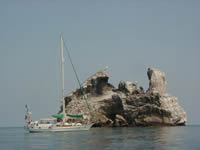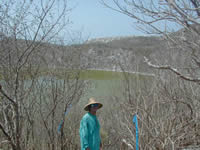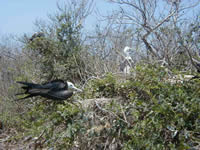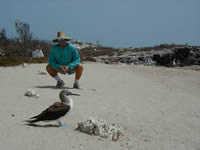|
Volume 70
20 May, 2002
Isla Isabela
Now THIS is
what cruising is supposed to be like!! If the Sea of Cortez comes
close to the attractions of our current spot, IT will have all been
worth it. As if we've been suffering these past months! Well, mainland
Mexico has been fun, but...the hordes of cruisers and the glitzy
tourism was really not what we came seeking.
 What
we came seeking is a place like Isla Isabela. Twenty-five miles
from the mainland, 80 miles south of Mazatlan, and 270 miles(approx)
SE of La Paz, Isla Isabela is a lump of rock that gazillions of
birds call home. But for a warden, several transient fisherman,
and occasionally some researchers from Guadalajara University, it
is uninhabited. It is too far from any town for there to be any
day excursion business, so the only "tourists" likely
to come by are cruisers. However, almost every mention of Isabela
we have heard over the cruisers' radio nets bewails some problem
that has forced them to abort their stop there. Either the winds
were from a bad direction, people's anchors were getting fouled
in rock, hostile fishermen chased them out, or there was a ban on
anchoring. It may simply be that the anchorages look cramped for
much more than one or two boats. The scuttlebutt was so persuasive,
that our longtime traveling companions Mac and Sam sailed right
on past to Mazatlan leaving us on our own to take a closer look. What
we came seeking is a place like Isla Isabela. Twenty-five miles
from the mainland, 80 miles south of Mazatlan, and 270 miles(approx)
SE of La Paz, Isla Isabela is a lump of rock that gazillions of
birds call home. But for a warden, several transient fisherman,
and occasionally some researchers from Guadalajara University, it
is uninhabited. It is too far from any town for there to be any
day excursion business, so the only "tourists" likely
to come by are cruisers. However, almost every mention of Isabela
we have heard over the cruisers' radio nets bewails some problem
that has forced them to abort their stop there. Either the winds
were from a bad direction, people's anchors were getting fouled
in rock, hostile fishermen chased them out, or there was a ban on
anchoring. It may simply be that the anchorages look cramped for
much more than one or two boats. The scuttlebutt was so persuasive,
that our longtime traveling companions Mac and Sam sailed right
on past to Mazatlan leaving us on our own to take a closer look.
Approaching
from the southeast, the southern anchorage, officially the better
one, was hard to pick out at first. In the "cruising season"
winds and swell are mostly from the north. What we saw in May was
huge rollers from the south breaking quite dramatically on jagged
volcanic cliffs. Standing well off, we persevered on a little farther
around until the cove finally opened up to reveal space for a boat
on the right and on the left the fishermen's playa with beached
pangas and nets spread to dry.. Since the southerly swell was making
it look anything but tranquil, we bore back off and went up the
island's east side to check out the secondary anchorage, a more
likely candidate in the current conditions of south swell and west
winds.
 We
found heaven. We inched our way into a cove guarded on the north
by two towering guano-covered pinnacles at the NE corner of the
island, and set our hook in sand in about 20-30' of water. The water
was flat calm and so crystal clear we could see the fish on the
bottom. The shore was a mix of sand and rock ledges, and gentle
waves made satisfactory surf sound as they broke over them, Boobies,
pelicans, frigate birds soared overhead, and the many more ashore
in the trees put up a steady undercurrent of bird chatter. We
found heaven. We inched our way into a cove guarded on the north
by two towering guano-covered pinnacles at the NE corner of the
island, and set our hook in sand in about 20-30' of water. The water
was flat calm and so crystal clear we could see the fish on the
bottom. The shore was a mix of sand and rock ledges, and gentle
waves made satisfactory surf sound as they broke over them, Boobies,
pelicans, frigate birds soared overhead, and the many more ashore
in the trees put up a steady undercurrent of bird chatter.
The snorkeling
was great. Finally, clear warm water (84*), and no jelly fish. We
went twice, right after arrival from the back of the boat and, the
next day, from the dinghy so we could circum-swim both pinnacles.
There we found piles of boulders in water barely 10-15' deep between
the pinnacles and a sheer drop to maybe forty feet on their outside.
In each little corner, there were very different populations So
many fish! Dozens of huge, flowing schools, lots of variety of species,
including the ever exotic Moorish Idols, and even some big standouts
like yellowfin tuna, spade fish, green morays, sting rays, guitar
fish, and an eagle ray!
Venturing ashore,
we found the island itself very dry and not especially pretty. The
trees have not leafed out yet, still waiting for rainy season. Although
rainy season has officially started, we have seen barely more than
a sprinkle so far. Leafless or not, the 15'-tall forest is home
to thousands  of
nestling and fledgling blue-footed boobies, brown boobies and frigate
birds. Both on the beach and on the path through the forest (ascending
to a green crater lake), we found ourselves allowed to approach
to within 2-3' of all these! What characters they are, especially
the blue footed boobies! Some quack while others whistle. We are
not clear on the distinction. We didn't recognize any "dancing"
(the characteristic courtship ritual), but with bright blue feet
every step and slide is eye catching! The really cute ball-of-fluff
stage appeared to be past by a month or so, although there were
alot of ladies sitting on nests...the boobies on the ground and
the frigates in the trees! The teenager boobies bounce along the
ground trying to learn to fly, while the adolescent frigates in
their molting phase are still anchored in their nests and seem oversize.
Frigates are silent, but they are the masters of flight. We didn't
see any frigates who looked anything but expert in the air. We witnessed
numerous instances of gang warfare between the species as the frigates
harassed boobies over the water, forcing them down. Since the frigates
can't get wet, the surface is a safe place for the boobies, but
every time the booby being picked on tries to take off, one to five
frigates heckle him back down! We figure these are young boobies
trying to learn to fish, and as the frigates are thieves, we guess
they are just getting necessary lessons in life. There are also
brown pelicans, Hernmann's gulls, and white terns, but these don't
seem to be nesting. Mostly they hang out on the pinnacles along
with the adult boobies in segregated condo communities. of
nestling and fledgling blue-footed boobies, brown boobies and frigate
birds. Both on the beach and on the path through the forest (ascending
to a green crater lake), we found ourselves allowed to approach
to within 2-3' of all these! What characters they are, especially
the blue footed boobies! Some quack while others whistle. We are
not clear on the distinction. We didn't recognize any "dancing"
(the characteristic courtship ritual), but with bright blue feet
every step and slide is eye catching! The really cute ball-of-fluff
stage appeared to be past by a month or so, although there were
alot of ladies sitting on nests...the boobies on the ground and
the frigates in the trees! The teenager boobies bounce along the
ground trying to learn to fly, while the adolescent frigates in
their molting phase are still anchored in their nests and seem oversize.
Frigates are silent, but they are the masters of flight. We didn't
see any frigates who looked anything but expert in the air. We witnessed
numerous instances of gang warfare between the species as the frigates
harassed boobies over the water, forcing them down. Since the frigates
can't get wet, the surface is a safe place for the boobies, but
every time the booby being picked on tries to take off, one to five
frigates heckle him back down! We figure these are young boobies
trying to learn to fish, and as the frigates are thieves, we guess
they are just getting necessary lessons in life. There are also
brown pelicans, Hernmann's gulls, and white terns, but these don't
seem to be nesting. Mostly they hang out on the pinnacles along
with the adult boobies in segregated condo communities.
 We
may have been all alone at anchor, but we were not the only humans
around. There are the fishermen who motor out at dusk from the south
anchorage to set their nets and then motor back at dawn to haul
them. Two pangas came by to trade fish and lobster. They wanted
cigarettes, which we don't carry, but happily made do with Cokes,
candy and cookies! (Their request.) Mostly they wanted to chat a
bit. Since we had heard tales of yachts being forced out by fishermen
here, we were happy for the friendly reception. Also, camping at
the end of our beach was young couple (well a guy and a gal) from
Guadalajara University who were tagging, weighing birds and counting
eggs. Interesting to watch. Their campsite was pretty rustic: one
tarp over their supplies and another staked out on the ground! Good
for star watching! We
may have been all alone at anchor, but we were not the only humans
around. There are the fishermen who motor out at dusk from the south
anchorage to set their nets and then motor back at dawn to haul
them. Two pangas came by to trade fish and lobster. They wanted
cigarettes, which we don't carry, but happily made do with Cokes,
candy and cookies! (Their request.) Mostly they wanted to chat a
bit. Since we had heard tales of yachts being forced out by fishermen
here, we were happy for the friendly reception. Also, camping at
the end of our beach was young couple (well a guy and a gal) from
Guadalajara University who were tagging, weighing birds and counting
eggs. Interesting to watch. Their campsite was pretty rustic: one
tarp over their supplies and another staked out on the ground! Good
for star watching!
We could have
stayed indefinitely, but now our appetite is even more whet for
the glories of Baja and the Se of Cortez! On the morning of May
16, we set out on a glassy sea on a course of 296* for a two-day,
272nm diagonal crossing of the Sea of Cortez to La Paz. There's
not a breath of wind, the engine is purring (thank God for that
Mystery Oil), and our fishing lines are out! See you there!
|

 What
we came seeking is a place like Isla Isabela. Twenty-five miles
from the mainland, 80 miles south of Mazatlan, and 270 miles(approx)
SE of La Paz, Isla Isabela is a lump of rock that gazillions of
birds call home. But for a warden, several transient fisherman,
and occasionally some researchers from Guadalajara University, it
is uninhabited. It is too far from any town for there to be any
day excursion business, so the only "tourists" likely
to come by are cruisers. However, almost every mention of Isabela
we have heard over the cruisers' radio nets bewails some problem
that has forced them to abort their stop there. Either the winds
were from a bad direction, people's anchors were getting fouled
in rock, hostile fishermen chased them out, or there was a ban on
anchoring. It may simply be that the anchorages look cramped for
much more than one or two boats. The scuttlebutt was so persuasive,
that our longtime traveling companions Mac and Sam sailed right
on past to Mazatlan leaving us on our own to take a closer look.
What
we came seeking is a place like Isla Isabela. Twenty-five miles
from the mainland, 80 miles south of Mazatlan, and 270 miles(approx)
SE of La Paz, Isla Isabela is a lump of rock that gazillions of
birds call home. But for a warden, several transient fisherman,
and occasionally some researchers from Guadalajara University, it
is uninhabited. It is too far from any town for there to be any
day excursion business, so the only "tourists" likely
to come by are cruisers. However, almost every mention of Isabela
we have heard over the cruisers' radio nets bewails some problem
that has forced them to abort their stop there. Either the winds
were from a bad direction, people's anchors were getting fouled
in rock, hostile fishermen chased them out, or there was a ban on
anchoring. It may simply be that the anchorages look cramped for
much more than one or two boats. The scuttlebutt was so persuasive,
that our longtime traveling companions Mac and Sam sailed right
on past to Mazatlan leaving us on our own to take a closer look.
 We
found heaven. We inched our way into a cove guarded on the north
by two towering guano-covered pinnacles at the NE corner of the
island, and set our hook in sand in about 20-30' of water. The water
was flat calm and so crystal clear we could see the fish on the
bottom. The shore was a mix of sand and rock ledges, and gentle
waves made satisfactory surf sound as they broke over them, Boobies,
pelicans, frigate birds soared overhead, and the many more ashore
in the trees put up a steady undercurrent of bird chatter.
We
found heaven. We inched our way into a cove guarded on the north
by two towering guano-covered pinnacles at the NE corner of the
island, and set our hook in sand in about 20-30' of water. The water
was flat calm and so crystal clear we could see the fish on the
bottom. The shore was a mix of sand and rock ledges, and gentle
waves made satisfactory surf sound as they broke over them, Boobies,
pelicans, frigate birds soared overhead, and the many more ashore
in the trees put up a steady undercurrent of bird chatter. of
nestling and fledgling blue-footed boobies, brown boobies and frigate
birds. Both on the beach and on the path through the forest (ascending
to a green crater lake), we found ourselves allowed to approach
to within 2-3' of all these! What characters they are, especially
the blue footed boobies! Some quack while others whistle. We are
not clear on the distinction. We didn't recognize any "dancing"
(the characteristic courtship ritual), but with bright blue feet
every step and slide is eye catching! The really cute ball-of-fluff
stage appeared to be past by a month or so, although there were
alot of ladies sitting on nests...the boobies on the ground and
the frigates in the trees! The teenager boobies bounce along the
ground trying to learn to fly, while the adolescent frigates in
their molting phase are still anchored in their nests and seem oversize.
Frigates are silent, but they are the masters of flight. We didn't
see any frigates who looked anything but expert in the air. We witnessed
numerous instances of gang warfare between the species as the frigates
harassed boobies over the water, forcing them down. Since the frigates
can't get wet, the surface is a safe place for the boobies, but
every time the booby being picked on tries to take off, one to five
frigates heckle him back down! We figure these are young boobies
trying to learn to fish, and as the frigates are thieves, we guess
they are just getting necessary lessons in life. There are also
brown pelicans, Hernmann's gulls, and white terns, but these don't
seem to be nesting. Mostly they hang out on the pinnacles along
with the adult boobies in segregated condo communities.
of
nestling and fledgling blue-footed boobies, brown boobies and frigate
birds. Both on the beach and on the path through the forest (ascending
to a green crater lake), we found ourselves allowed to approach
to within 2-3' of all these! What characters they are, especially
the blue footed boobies! Some quack while others whistle. We are
not clear on the distinction. We didn't recognize any "dancing"
(the characteristic courtship ritual), but with bright blue feet
every step and slide is eye catching! The really cute ball-of-fluff
stage appeared to be past by a month or so, although there were
alot of ladies sitting on nests...the boobies on the ground and
the frigates in the trees! The teenager boobies bounce along the
ground trying to learn to fly, while the adolescent frigates in
their molting phase are still anchored in their nests and seem oversize.
Frigates are silent, but they are the masters of flight. We didn't
see any frigates who looked anything but expert in the air. We witnessed
numerous instances of gang warfare between the species as the frigates
harassed boobies over the water, forcing them down. Since the frigates
can't get wet, the surface is a safe place for the boobies, but
every time the booby being picked on tries to take off, one to five
frigates heckle him back down! We figure these are young boobies
trying to learn to fish, and as the frigates are thieves, we guess
they are just getting necessary lessons in life. There are also
brown pelicans, Hernmann's gulls, and white terns, but these don't
seem to be nesting. Mostly they hang out on the pinnacles along
with the adult boobies in segregated condo communities. We
may have been all alone at anchor, but we were not the only humans
around. There are the fishermen who motor out at dusk from the south
anchorage to set their nets and then motor back at dawn to haul
them. Two pangas came by to trade fish and lobster. They wanted
cigarettes, which we don't carry, but happily made do with Cokes,
candy and cookies! (Their request.) Mostly they wanted to chat a
bit. Since we had heard tales of yachts being forced out by fishermen
here, we were happy for the friendly reception. Also, camping at
the end of our beach was young couple (well a guy and a gal) from
Guadalajara University who were tagging, weighing birds and counting
eggs. Interesting to watch. Their campsite was pretty rustic: one
tarp over their supplies and another staked out on the ground! Good
for star watching!
We
may have been all alone at anchor, but we were not the only humans
around. There are the fishermen who motor out at dusk from the south
anchorage to set their nets and then motor back at dawn to haul
them. Two pangas came by to trade fish and lobster. They wanted
cigarettes, which we don't carry, but happily made do with Cokes,
candy and cookies! (Their request.) Mostly they wanted to chat a
bit. Since we had heard tales of yachts being forced out by fishermen
here, we were happy for the friendly reception. Also, camping at
the end of our beach was young couple (well a guy and a gal) from
Guadalajara University who were tagging, weighing birds and counting
eggs. Interesting to watch. Their campsite was pretty rustic: one
tarp over their supplies and another staked out on the ground! Good
for star watching!
